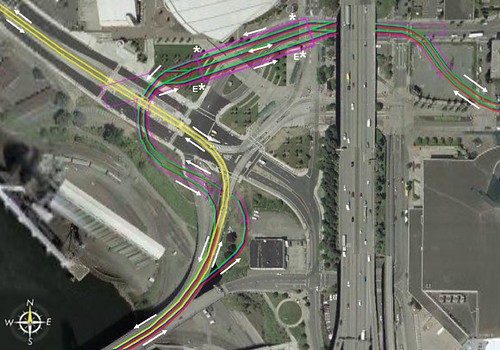Fixing the Rose Quarter Bottleneck
Over at Portland Transport--a place I have come to rely on for useful information--commenter "Bob R" has become contributor Bob Richardson, and his first submission is a doozy: "How I Would Untangle the Rose Quarter:"
Relying on Google Earth to illustrate both the problem and the solution really helps explain Richardson's idea. What an amazing tool! Here's his conception of how it would look (click to enlarge):

As you can see, Bob's idea is to move the Blue/Red/Green lines away from the current configuration and put it underneath the front grounds of the Rose Garden, then have them approach the Steel Bridge bottleneck from the west, rather than the east. This not only opens up several street segments for cars to pass through the Quarter more easily--and prevents the train from having to wait for them if they miss the signal.
In addition, passengers needed to transfer to the Yellow Line would need much less effort to get there (a time- but also safety benefit), and visitors to the Rose Garden and Coliseum would also be closer to their destinations.
But the real beauty of this remodel is that it can be done almost entirely without disrupting current service--even without condemning any property, apparently. That's a big plus. And when it's finished, not only will capacity be protected by eliminating typical delays (as when trains miss signals because someone forced a door open, or when pedestrians are streaming in front of the train and cars after a Rose Garden event, etc.), but future possible renovations (such as a 3-car platform and subway rough-ins) are already preconceived in Bob's design.
While many interests are bothered by the serpentine design or the lack of parking or public safety or Mall capacity, the only criticism that seems to hold up for me is the issue at the Steel Bridge chokepoint. This doesn't eliminate that chokepoint, but the plan does mitigate the problem, and tries to prevent inevitable delays from having a serious and compounding system impact, when even a few seconds can throw things off for hours. I encourage you to look closely at his plan and offer your own comments on a work in progress. But this is some great work, allowing us to kick around ideas to make downtown transit more effective using a clear visual model to work from. Kudos!
As some transit advocates (including AORTA) have pointed out, the capacity of these interlocks constrains the potential for growth of the light rail system. With the addition of the MAX Green Line from Clackamas, the area may approach the practical limit for trains per hour of throughput within a decade.
Expanding capacity beyond the current limit presents a conundrum: How do you redo this complex interchange without shutting down the current rail system, which would have drastic short term and medium term impacts on ridership? Furthermore, how can the area be configured to accommodate future proposals such as a new river crossing (bridge or tunnel) or longer trains?
I propose the development of an underground station at the Rose Quarter for the Blue/Red/Green lines in a manner which presents many options for future expansion, eliminates several current conflicts, and provides greater rider convenience.
Relying on Google Earth to illustrate both the problem and the solution really helps explain Richardson's idea. What an amazing tool! Here's his conception of how it would look (click to enlarge):

As you can see, Bob's idea is to move the Blue/Red/Green lines away from the current configuration and put it underneath the front grounds of the Rose Garden, then have them approach the Steel Bridge bottleneck from the west, rather than the east. This not only opens up several street segments for cars to pass through the Quarter more easily--and prevents the train from having to wait for them if they miss the signal.
In addition, passengers needed to transfer to the Yellow Line would need much less effort to get there (a time- but also safety benefit), and visitors to the Rose Garden and Coliseum would also be closer to their destinations.
But the real beauty of this remodel is that it can be done almost entirely without disrupting current service--even without condemning any property, apparently. That's a big plus. And when it's finished, not only will capacity be protected by eliminating typical delays (as when trains miss signals because someone forced a door open, or when pedestrians are streaming in front of the train and cars after a Rose Garden event, etc.), but future possible renovations (such as a 3-car platform and subway rough-ins) are already preconceived in Bob's design.
While many interests are bothered by the serpentine design or the lack of parking or public safety or Mall capacity, the only criticism that seems to hold up for me is the issue at the Steel Bridge chokepoint. This doesn't eliminate that chokepoint, but the plan does mitigate the problem, and tries to prevent inevitable delays from having a serious and compounding system impact, when even a few seconds can throw things off for hours. I encourage you to look closely at his plan and offer your own comments on a work in progress. But this is some great work, allowing us to kick around ideas to make downtown transit more effective using a clear visual model to work from. Kudos!







<< Home